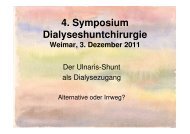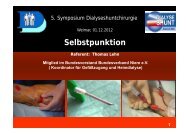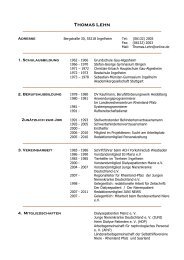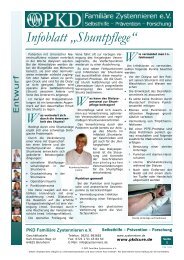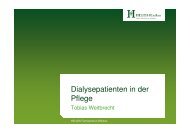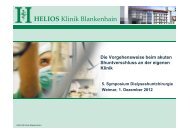History of vascular access for haemodialysis - Shunt
History of vascular access for haemodialysis - Shunt
History of vascular access for haemodialysis - Shunt
Create successful ePaper yourself
Turn your PDF publications into a flip-book with our unique Google optimized e-Paper software.
Nephrol Dial Transplant (2005) 20: 2629–2635doi:10.1093/ndt/gfi168Advance Access publication 4 October 2005Historical Note(Section Editor: G. Eknoyan)<strong>History</strong> <strong>of</strong> <strong>vascular</strong> <strong>access</strong> <strong>for</strong> <strong>haemodialysis</strong>Klaus KonnerMedizinische Klinik I, Krankenhaus Ko¨ln-Merheim, Ko¨ln, GermanyAbstractThe history <strong>of</strong> <strong>vascular</strong> <strong>access</strong> is a history <strong>of</strong> <strong>vascular</strong>surgery as well as a history <strong>of</strong> dialysis therapy. Thissurvey is a personal view on the history <strong>of</strong> <strong>vascular</strong><strong>access</strong> without the ambition to cover every detail,but with an ef<strong>for</strong>t to mention the major steps in afascinating panorama.How it all started1896Jaboulay and Briau (Lyon, France) published anexperimental technique in dogs which consisted<strong>of</strong> suturing an artery-end-to-end-anastomosis. Theauthors already mentioned technical details proposedagain in current literature, e.g. the eversion <strong>of</strong> thesuture, an essential tool against thrombosis (Figure 1)[1]. A few years later, Alexis Carrel, who grew upin Lyon, later moved to Chicago, Baltimore andNew York, introduced the three-point end-to-endanda side-to-side-anastomosis, a milestone and stillused today (Figure 2) [2]. Carrel was awarded theNobel Prize in 1912.1924In October 1924, Georg Haas (Giessen, Germany)per<strong>for</strong>med the first <strong>haemodialysis</strong> treatment in humanswhich lasted 15 min. He was supported by a grantfrom the Rockefeller Foundation. He first used glasscannulae to obtain arterial blood from the radialartery, which he returned to the cubital vein. Later heper<strong>for</strong>med a surgical cut-down to place a cannula intothe radial artery and into an adjacent vein. Asan anticoagulant, he initially used a purified hirudinpreparation which nevertheless caused severe reactionsso that from 1927 onward hirudin was replaced by theCorrespondence and <strong>of</strong>fprint requests to: Klaus Konner,Medizinische Klinik I, Krankenhaus Ko¨ln-Merheim, Ko¨ln,Germany. Email: klaus.konner@uni.koeln.denon-toxic heparin. Till 1929, he per<strong>for</strong>med eleventreatments in uraemic patients. He did not continue,however, presumably because <strong>of</strong> the limited efficacyand the lack <strong>of</strong> recognition by his peers. He died in 1971having witnessed the arrival <strong>of</strong> modern <strong>haemodialysis</strong>techniques.1943Modern <strong>haemodialysis</strong> therapy started on 17 March1943, when Willem Kolff, a young doctor in the smallhospital <strong>of</strong> Kampen (The Netherlands), treated a29-year-old housemaid suffering from malignanthypertension and ‘contracted kidneys’. Kolff hadconstructed a ‘rotating drum kidney’ with the support<strong>of</strong> Mr Berk, the director <strong>of</strong> the local enamel factory.First, Kolff used only venipuncture needles to obtainblood from the femoral artery and to reinfuse it bypuncturing a vein. Later, he per<strong>for</strong>med surgical cutdown<strong>of</strong> the radial artery which caused severe bleedingduring heparinization. On 11 September 1945 the first<strong>of</strong> his 17 patients survived, a 67-year-old woman withcholecystitis and sulphonamide nephrotoxicity. Kolffleft the Netherlands in 1950 and continued to work inthe field <strong>of</strong> artificial organs in the USA.In the years that followed, substantial technicaldevelopments are linked to the names <strong>of</strong> Nils Alwall inLund (Sweden) and John P. Merril in Boston (USA).In the 1950s, the technical devices were available <strong>for</strong>regular <strong>haemodialysis</strong> treatments, e.g. Kolff ’s so-calledtwin-coil kidney [3] – but, the Achilles heel was areliable <strong>access</strong> to the circulation <strong>for</strong> multiple use whichdid not yet exist.The pioneers <strong>of</strong> maintenance <strong>haemodialysis</strong>1960In 1949, Allwall tried to use a rubber tubing and glasscannula device to connect artery and vein, but he failed.This idea <strong>of</strong> Alwall was later taken up by Quinton,Dillard and Scribner (Seattle, USA) who developedan arteriovenous (AV) Teflon shunt [4]. Only 10 weeksDownloaded from http://ndt.ox<strong>for</strong>djournals.org/ by guest on February 20, 2012ß The Author [2005]. Published by Ox<strong>for</strong>d University Press on behalf <strong>of</strong> ERA-EDTA. All rights reserved.For Permissions, please email: journals.permissions@ox<strong>for</strong>djournals.org
2630 K. KonnerFig. 1. Animal experiments with <strong>vascular</strong> anastomoses by Jaboulay and Briau, published 1896 [1].Fig. 2. Three-point-end-to-end anastomosis by Carrel, published1912 [2].after the first patient, Clyde Shields, had been takenon maintenance <strong>haemodialysis</strong>, Scribner published a‘Preliminary report on the treatment <strong>of</strong> chronic uremiaby means <strong>of</strong> intermittent hemodialysis’, which describedwith clairvoyance some medical problems plaguingrenal replacement therapy still today: malnutrition,hypertension, anaemia and others [5]. Clyde Shields,a Boeing machinist, survived <strong>for</strong> 11 years after theinsertion <strong>of</strong> his first AV shunt on 9 March 1960.Two thin-walled Teflon cannulas with tapered endswere inserted near the wrist in the <strong>for</strong>earm, one into theradial artery and the other into the adjacent cephalicvein. The external ends were connected by a curvedteflon bypass tube. Later, the Teflon tube was replacedby flexible silicon rubber tubing.Scribner wrote in 1990: ‘Successful treatment <strong>of</strong>Clyde Shields represents one <strong>of</strong> the few instances inmedicine where a single success was required to validatea new therapy’ [6]. The development <strong>of</strong> a permanent<strong>vascular</strong> <strong>access</strong> by the Seattle group was the decisivebreakthrough, which made maintenance dialysispossible. It is rightly considered a landmark in thehistory <strong>of</strong> dialysis: maintenance <strong>haemodialysis</strong> therapybegan on 9 March 1960. Many variants <strong>of</strong> the AV shuntcame into use during the following years when themajority <strong>of</strong> AV-shunt insertions concerned temporary<strong>vascular</strong> <strong>access</strong> at the start <strong>of</strong> chronic dialysis therapyto bridge the time when an AV fistula was absentor maturing.During early 1970s, TJ Buselmeier andco-workers (Minneapolis, USA) developed a compactU-shaped silastic prosthetic AV shunt with either oneor two Teflon plugged outlets which communicated tothe outside <strong>of</strong> the body. The U-shaped portion couldbe totally or partially implanted subcutaneously [7].This modification <strong>of</strong> the Scribner AV shunt gainedsome acceptance during the following years, especially<strong>for</strong> paediatric <strong>haemodialysis</strong> patients.1961At that time, Stanley Shaldon (London, UK) facedthe problem <strong>of</strong> finding a surgeon willing to operate onthe radial artery and cephalic vein to introducecannulae <strong>for</strong> circulatory <strong>access</strong>. To become independent,Shaldon introduced hand-made catheters intothe femoral artery and vein by the percutaneousDownloaded from http://ndt.ox<strong>for</strong>djournals.org/ by guest on February 20, 2012
<strong>History</strong> <strong>of</strong> <strong>vascular</strong> <strong>access</strong> <strong>for</strong> <strong>haemodialysis</strong> 2631Seldinger technique <strong>for</strong> immediate <strong>vascular</strong> <strong>access</strong> [8,9].Over time, vessels in different sites were used, includingthe subclavian vein. Shaldon concluded: ‘Eventually,veno-venous catheterization was preferred because thebleeding from the femoral vein was less than from thefemoral artery when the catheter was removed’ [10].Regional heparinization was practised with hexadimethrinebromide (‘Polybrene’) to neutralize the anticoagulanteffect <strong>of</strong> heparin. Obviously, these cathetersare not identical with the widely used type <strong>of</strong> catheters<strong>for</strong> temporary <strong>access</strong>, which today are usually called‘Shaldon catheters’.1962James E. Cimino and Michael J. Brescia (New York,USA) described a ‘simple venipuncture <strong>for</strong> hemodialysis’based on the experience <strong>of</strong> Dr Cimino whenhe worked part-time as a student at the BellevueTransfusion Center in New York [11]. After priorinfiltration <strong>of</strong> the overlying skin with 1% procaine, themost <strong>access</strong>ible <strong>for</strong>earm vein was punctured with aneedle. Needle sizes varied from No. 16 to No. 12gauge. Patency <strong>of</strong> the vein and adequate blood supplywere assured by application <strong>of</strong> tourniquet pressurewith a sphygmomanometer. A blood flow in the range<strong>of</strong> 150 and 410 ml/min was obtained in these mainlyfluid overloaded patients.1963Thomas J. Fogarty from Cincinnati, USA, inventedan intra<strong>vascular</strong> catheter with an inflatable balloonat its distal tip designed <strong>for</strong> embolectomy andthrombectomy – an essential device even today [12].1966The legendary paper ‘Chronic hemodialysis usingvenipuncture and a surgically created arteriovenousfistula’ was published by Brescia, Cimino, Appell andHurwich [13]. Dr Appell was the surgeon in the team.The first surgically created fistula <strong>for</strong> the purpose<strong>of</strong> <strong>haemodialysis</strong> was placed on 19 February 1965,followed by further 14 operations as <strong>of</strong> 21 June 1966.Twelve out <strong>of</strong> these 14 AV fistulae resumed primaryfunction without complications, two never functioned(in the first patient, the anastomosis ‘was made toosmall’). This represents an early failure rate whichwould be admirably low even in 2005. Dr Scribnerfrom Seattle was the first nephrologist to refer one<strong>of</strong> his patients to New York <strong>for</strong> the creation <strong>of</strong> anAV fistula.Dr Appel had per<strong>for</strong>med a side-to-side-anastomosisbetween the radial artery and the cephalic antebrachialvein at the wrist after a 3–5 mm incision had been madein the corresponding lateral surfaces <strong>of</strong> the artery andthe vein. The suture was achieved using arterial silk incontinuous fashion.Many years later, in 1994, Dr Cimino stated that‘the decision to connect an artery and vein subcutaneously,thus creating an internal shunt, appeared notonly logical but was the classic example <strong>of</strong> necessityas the mother <strong>of</strong> invention’ and ‘that arteriovenousfistulas could lead to heart failure, and this would beparticularly hazardous in patients whose cardio<strong>vascular</strong>systems were already compromised’ [14].Drs Cimino and Appell left the VeteransAdministration Hospital, Bronx, New York, a fewyears later: Dr Cimino is still busy practising palliativemedicine at the Calvary Hospital, Bronx, New York;Dr Appell has retired after a successful careeras a ‘countryside’ general surgeon in the greaterNew York area [Personal communication, April 2005].1967One year after the article <strong>of</strong> Brescia and Cimino,M. Sperling (Wu¨rzburg, Germany) reported thesuccessful creation <strong>of</strong> an end-to-end-anastomosisbetween the radial artery and the cephalic antebrachialvein in the <strong>for</strong>earm <strong>of</strong> 15 patients using a stapler [15].This type <strong>of</strong> AV anastomosis gained widespreadacceptance during the next decade, mainly based onthe rationale to restrict the inflow <strong>of</strong> blood into the AVfistulae to the flow provided by the feeding radialartery. The creation <strong>of</strong> an end-to-end anastomosis wastechnically challenging; an additional problem arosebecause the diameters <strong>of</strong> artery and vein were different;various patch techniques were tried to solve thisproblem. Because <strong>of</strong> the increasing numbers <strong>of</strong> elderly,hypertensive and diabetic patients with difficultvessels and high risk <strong>of</strong> a steal syndrome, this type<strong>of</strong> AV fistula was abandoned as the first <strong>vascular</strong><strong>access</strong> <strong>of</strong> choice. End-to-end-anastomoses are still awell established technique in revision procedures. Thestapler, however, never was accepted as a routinetechnical tool.For the transluminal recanalization <strong>of</strong> arteriesobstructed by atherosclerotic plaques Charles T.Dotter and co-workers (Portland, USA) introduceda type <strong>of</strong> balloon catheter. The first angioplastyrepresented an essential contribution to resolve one<strong>of</strong> the great problems in <strong>vascular</strong> surgery and <strong>vascular</strong><strong>access</strong> surgery [16].1968Lars Ro¨hl from Heidelberg, Germany, publishedhis results in 30 radial-artery-side-to-vein-endanastomoses[17]. After completion <strong>of</strong> the anastomosis,the radial artery was ligated distal to theanastomosis, thus resulting in a functional end-toend-anastomosis.With this technique, an antebrachialcephalic vein located at a more lateral position whichwould not have been suitable <strong>for</strong> a side-to-sideanastomosis,could be used successfully. Later on,the ligation <strong>of</strong> the peripheral arterial limb only waspractised in patients with impending signs <strong>of</strong> peripheralischaemia.Today, the artery-side-to-vein-end-anastomosishas become a standard procedure. The handling <strong>of</strong>Downloaded from http://ndt.ox<strong>for</strong>djournals.org/ by guest on February 20, 2012
2632 K. Konnerthe ‘free end’ <strong>of</strong> the vein should not be underestimated,however. Torsion and kinking <strong>of</strong> the vessel un<strong>for</strong>tunatelyare common errors that predispose to fistulafailure.1969In 1952, the French anatomist Robert Aubaniac, livingin Algeria, had described the puncture <strong>of</strong> the subclavianvein [18]. After the first use <strong>of</strong> the subclavian route<strong>for</strong> <strong>haemodialysis</strong> <strong>access</strong> by Shaldon in 1961, thistechnique was adapted by Josef Erben from the <strong>for</strong>merCzechoslovakia, using the infraclavicular route [19].In addition, this catheter permitted to control centralvenous pressure in dehydrated, oliguric <strong>haemodialysis</strong>patients. During the following two decades thesubclavian approach was the preferred route <strong>for</strong>temporary <strong>vascular</strong> <strong>access</strong> by central venous catheterization.Today, time has come to abandon subclaviancannulas in patients with chronic renal disease, sincephlebographic studies revealed a 50% stenosis orocclusion rate at the site <strong>of</strong> cannulation. This predisposesto oedema <strong>of</strong> the arm, especially after creation <strong>of</strong>an AV fistula [20].Based on animal experiments, George I. Thomasfrom Seattle, USA, presented his ‘Dacron appliqueshunt’ in 10 patients [21]. The idea was to eliminateall intraluminal <strong>for</strong>eign body, thus avoiding any areapredisposing to thrombus <strong>for</strong>mation. The authorsutured oval Dacron patches to the common femoralartery and the saphenous/common femoral vein.The Dacron patches were connected with silastictubes and brought to the surface <strong>of</strong> the anteriorthigh approximately 10 cm distal to the femoralwound. In desperate cases, some groups still use theThomas-shunt [22].For patients with lack <strong>of</strong> or exhaustion <strong>of</strong> peripheralveins, a new idea came up: Gilberto Flores Izquierdo(Mexico City) [23] and James May (Sidney, Australia)[24] proposed to remove the segment <strong>of</strong> the saphenousvein between groin and knee and to connect it in aU-shaped fashion in the elbow region with thebrachial artery and a suitable vein. As a variant it wasproposed to implant the totally mobilized vein to thegreat vessels in the thigh or to anastomose the distallymobilized saphenous vein to the femoral artery.The first step <strong>of</strong> using a graft in <strong>vascular</strong> <strong>access</strong>surgery was done. In 1970, Roland E. Girardet fromNew York, USA, analysed his results with this noveltechnique [25].femoral artery was exposed, the musculus sartoriuswas mobilized. Both ends <strong>of</strong> the musculus sartoriuswere passed underneath the exposed artery and joinedagain. The fascia lata was closed, ensuring thatproximal and distal openings <strong>of</strong> the fascia weresufficiently large to prevent compression <strong>of</strong> the artery.Seventeen patients had undergone this proceduresuccessfully.The first clinical results with a mandril graft werereported by Charles H. Sparks (Portland, USA) basedon a series <strong>of</strong> animal experiments starting in 1965 [27].He implanted a silicone mandril assembly consisting <strong>of</strong>a silicone rubber rod with a covering <strong>of</strong> two speciallyprepared siliconized knitted Dacron tubes. It was leftin place <strong>for</strong> 6 weeks so that the Dacron mesh becameorganized after invasion <strong>of</strong> the surrounding tissue. Themandril was then removed and the endings <strong>of</strong> thematured subcutaneous tunnel were anastomosed tothe native vessels. The first report on the use in<strong>haemodialysis</strong> patients was given by Beemer in 1973[28]. Because <strong>of</strong> the unfavourable results and theavailability <strong>of</strong> more successful prosthetic materialsthis technique was abandoned a few years later.1971G. Capodicasa from Naples (Italy) posed the question‘Is a shunt an indispensable requirement <strong>for</strong> repeated<strong>haemodialysis</strong>?’ and presented his technique <strong>of</strong>mobilizing and fixing the radial artery underneath theskin thoughout its length along the <strong>for</strong>earm [29], butthere were no further publications to confirm the value<strong>of</strong> this procedure.The first idea to implant a plastic valve as circulatory<strong>access</strong> was reported by W.D. Brittinger (Figure 3).Downloaded from http://ndt.ox<strong>for</strong>djournals.org/ by guest on February 20, 2012New ideas1970A ‘16 month’s experience with the subcutaneously fixedsuperficial femoral artery <strong>for</strong> chronic <strong>haemodialysis</strong>’was published by W.D. Brittinger (Mannheim,Germany) [26]. Following a femoral arteriogram toexclude arterial anomalies or disease, the superficialFig. 3. Plastic valve, experimentally implanted into a femoralartery, published 1971 [31] (courtesy <strong>of</strong> Pr<strong>of</strong>. W.D. Brittinger,Neckargemu¨nd, Germany).
<strong>History</strong> <strong>of</strong> <strong>vascular</strong> <strong>access</strong> <strong>for</strong> <strong>haemodialysis</strong> 2633In an animal model, he inserted a massive silasticcylinder with a Dacron skirt end-to-side into a sheepcarotid artery. The implantation <strong>of</strong> this device into ahuman superficialized femoral artery was planned, butun<strong>for</strong>tunately not realized [30].New types <strong>of</strong> graftshad already published this ‘retrograde venography’technique in AV shunts and fistulas 1 year be<strong>for</strong>ein a German radiologic journal [36].Andreas Gru¨ntzig from Zu¨rich, Switzerland,continued the work <strong>of</strong> Dotter using the then newcatheter technique to recanalize chronic arterial occlusions,the basis <strong>of</strong> modern angioplasty [37].1972The year 1972 saw the introduction <strong>of</strong> three new graftmaterials, one biologic and two synthetic.A modified bovine carotid artery biologic graft(Artegraft, Johnson & Johnson), a product <strong>of</strong> researchby D.M.L. Rosenberg, was introduced <strong>for</strong> construction<strong>of</strong> <strong>vascular</strong> <strong>access</strong> in eight <strong>haemodialysis</strong> patientsby Joel L. Chinitz [31] (Philadelphia, USA). It wasthe first xeno-graft and received some acceptanceduring the 1970s.T. Soyer (Denver, USA) used expanded polytetrafluoroethylene(ePTFE) in animal experiments toreplace various major thoracic and abdominal veins[32]. In 1976, L.D. Baker Jr (Phoenix, USA) presentedthe first results with expanded PTFE grafts in 72<strong>haemodialysis</strong> patients [33]. The majority <strong>of</strong> thesegrafts were 8 mm in diameter. Numerous publicationsduring the subequent years demonstrated the valueand the limitations <strong>of</strong> this prosthetic material, whichhas remained the first choice <strong>of</strong> grafts <strong>for</strong> <strong>vascular</strong><strong>haemodialysis</strong> <strong>access</strong> even today.Irving Dunn (Brooklyn, NY, USA) had chosen adacron velour <strong>vascular</strong> graft <strong>for</strong> creation <strong>of</strong> AV bridgegrafts, initially in animal experiments and then in auraemic female patient [34]. Subsequently, this materialdid not yield satisfactory results <strong>for</strong> <strong>vascular</strong> <strong>access</strong>,although in other fields <strong>of</strong> <strong>vascular</strong> surgery it hasbecome well accepted as graft material.The fact that Dacron was not accepted and thatePTFE continues to be the material <strong>of</strong> choice highlightsthe fact that in the field <strong>of</strong> <strong>vascular</strong> <strong>access</strong> specialcriteria must be met by the graft material: apart fromsafety and ease <strong>of</strong> handling during the operation, inaddition, no <strong>for</strong>mation <strong>of</strong> aneurysms after repeatedcannulation and low infection rates are required; easysurgical replacement <strong>of</strong> graft segments in cases <strong>of</strong>infected and aneurysmatic grafts is another importantprerequisite.1973T.W. Staple (St Louis, USA) described a novelangiographic technique in his paper ‘Retrogradevenography <strong>of</strong> subcutaneous arteriovenous fistulascreated surgically <strong>for</strong> hemodialysis’ [35]. During subsequentyears, further substantial contributions camefrom the St Louis group with Louis A. Gilula, theradiologist, and Charles B. Anderson, the <strong>vascular</strong>surgeon. This angiographic technique is still usedtoday, preferably in combination with the digitalsubtraction device. M. Thelen (Bonn, Germany)1976Two authors had worked <strong>for</strong> a few years with a newgraft material: the human umbilical cord vein because<strong>of</strong> the perceived advantages <strong>of</strong> an antithrombogenicintimal inner surface and the absence <strong>of</strong> valves andbranches. B.P. Mindich (New York) used chemicallyprocessed umbilical cord veins without external support,whereas H. Dardik (New York) surrounded thegraft with a polyester fibre mesh [38,39]. This materialnever achieved a real breakthrough because <strong>of</strong> insufficientresistance against the trauma <strong>of</strong> repeatedcannulation and <strong>of</strong> problematic surgical revision inthe case <strong>of</strong> aneurysm and infection.1977A group from Chicago with Dr Gracz as first authorpublished an article on ‘Proximal <strong>for</strong>earm fistula<strong>for</strong> maintenance hemodialysis’, a variant <strong>of</strong> an AVanastomosis. They sutured the per<strong>for</strong>ating vein to theproximal radial, ulnar or brachial artery [40]. Recently,a modification <strong>of</strong> this type <strong>of</strong> AV fistula gained someimportance as a <strong>vascular</strong> <strong>access</strong> in the old, hypertensiveand diabetic patients because it permits a proximalanastomosis with a low risk <strong>of</strong> hypercirculation, asblood flow is limited by the finite diameter <strong>of</strong> theper<strong>for</strong>ating vein (3–5 mm) [41].1979A.L. Golding and co-workers (Los Angeles, USA)developed a ‘carbon transcutaneous hemodialysis<strong>access</strong> device’ (CATD), commonly known as ‘button’,as a blood <strong>access</strong> not requiring needle puncture [42].The device consisted <strong>of</strong> two components: a vitreouscarbon <strong>access</strong> port sealed with a conical polyethyleneplug and a PTFE graft securely and smoothly attachedto the port. It could easily be connected with speciallyconstructed bloodlines. As a procedure <strong>of</strong> third choice,these devices were expensive and never gained widespreadacceptance.F.L. Shapiro (Minneapolis, USA) described anothertype <strong>of</strong> ‘button’, a device similar to that developedby Golding [43]. In 1983, J.L. Wellington (Ottawa,Canada) tried to implant these buttons along anarterialized, superficialized basilic vein – a promisingidea, but the results were disappointing [Personalcommunication, 1983]. Because only few groups usedthese devices, the experience remained limited.A remarkable publication came from Joseph L.Giacchino (Maywood, USA) discussing uncommonDownloaded from http://ndt.ox<strong>for</strong>djournals.org/ by guest on February 20, 2012
2634 K. Konnertechniques like the reverse AV fistula, unusually locatedinterposition grafts and brachio-brachial arterioarterialgrafts[44].The first report on a new angiographic technique,known as digital subtraction angiography waspublished by David L. Ergun (Madison, USA):‘A hybrid computerized fluoroscopy technique<strong>for</strong> noninvasive cardio<strong>vascular</strong> imaging’. Later, thistechnique was adapted to visualize AV fistulas andprosthetic bridge grafts, using the arterial as well as thevenous route [45].Recent ideas1980–1992A highly in<strong>for</strong>mative paper was published by W.P. Geis,together with Dr Giacchino: ‘A game plan <strong>for</strong> <strong>vascular</strong><strong>access</strong> <strong>for</strong> hemodialysis’ – a collection <strong>of</strong> innovative,creative ideas concerning arteriovenous fistulas as wellas graft insertion in various locations [46].The era <strong>of</strong> the percutaneous, transluminal angioplastyin <strong>vascular</strong> <strong>access</strong>es started with a publication<strong>of</strong> David H. Gordon and Sidney Glanz (New York,USA) based on the work <strong>of</strong> Gru¨ntzig: ‘Treatment <strong>of</strong>stenotic lesions in dialysis <strong>access</strong> fistulas and shunts bytransluminal angioplasty’ [47].G. Kro¨nung (Bonn, Germany) published fundamentalideas on how different types <strong>of</strong> cannulation affectedthe remodelling <strong>of</strong> the venous arm <strong>of</strong> the fistula [48].He demonstrated that cannulation may not onlydestroy the vein, but is essential <strong>for</strong> remodelling.Thus, cannulation can be an effective tool to avoidthe <strong>for</strong>mation <strong>of</strong> aneurysms and stenoses.In patients with exhausted vessel anatomy in botharms or stenoses along the subclavian vein resistant tointervention Jose´ R. Polo (Madrid, Spain) introducedthe concept <strong>of</strong> ‘brachial-jugular polytetrafluoroethylenefistulas <strong>for</strong> hemodialysis’ [49], a brilliant solution<strong>for</strong> the occasional patient who may pr<strong>of</strong>it fromcreation <strong>of</strong> a graft-vein-anastomosis using the internaljugular vein.While angiographic and interventional radiologictechniques became widely accepted, non-invasiveultrasound techniques, mainly used by nephrologists,were introduced only slowly. A landmark was thearticle <strong>of</strong> Barbara Nonnast-Daniel (Hannover,Germany) on ‘Colour doppler ultrasound assessment<strong>of</strong> arteriovenous <strong>haemodialysis</strong> fistulas’ [50]. She wasable to obtain anatomic and functional parameters,which were useful to guide the surgeon <strong>for</strong> optimizingthe procedure in the first <strong>access</strong> operation, but alsouseful <strong>for</strong> surveillance and monitoring the function<strong>of</strong> the <strong>access</strong> during follow-up.OutlookThe above remarks reflect the subjective assessment<strong>of</strong> what we consider are the highlights in past ef<strong>for</strong>ts tooptimize the <strong>vascular</strong> <strong>access</strong> in <strong>haemodialysis</strong> patients.Knowledge <strong>of</strong> these ingenious, innovative, sometimeseven bold ideas, although not always successful, isstimulating and hopefully also useful to the physicianstruggling with the challenge to construct <strong>vascular</strong><strong>access</strong>es nowadays. Creative ef<strong>for</strong>ts provided a variety<strong>of</strong> solutions in the past and so, we are happy today toplay on more than one instrument.Vacsular <strong>access</strong> surgery has become an interdisciplinaryfield <strong>of</strong> modern medicine. Once it had beeninaugurated by pioneers in nephrology at a time when<strong>access</strong> surgery was unknown in the then still youngdiscipline <strong>of</strong> <strong>vascular</strong> surgery. In the early 1970s, withthe increasing complexity <strong>of</strong> <strong>access</strong> related problems,nephrologists delegated the responsibilty <strong>for</strong> the<strong>vascular</strong> <strong>access</strong> more and more to their surgeons. Formany years, <strong>vascular</strong> <strong>access</strong> was regarded as anexclusively surgical problem. With the introduction <strong>of</strong>non-invasive preoperative mapping <strong>of</strong> blood vessels, <strong>of</strong>earlier referral to nephrologists and to <strong>access</strong> surgeonsand <strong>of</strong> venous preservation, nephrologists must learnagain to assume responsibility <strong>for</strong> <strong>vascular</strong> <strong>access</strong>.Beyond the preservation <strong>of</strong> vessels in the predialyticphase, this includes surveillance and monitoring <strong>of</strong>the established <strong>access</strong>, but also aquiring up-to-dateknowledge on the surgical options and many otheraspects, but above all maintaining close cooperationwith surgeons and radiologists.What is required today is a completely newapproach to comprehensive <strong>access</strong> management thathas to escape from crisis management. <strong>History</strong> may behelpful.Acknowledgements. I am indebted to Pr<strong>of</strong>. Eberhard Ritz,Heidelberg, Germany <strong>for</strong> insightful comments and review <strong>of</strong> themanuscript. Thanks also to Dr Dirk Hentschel, HavardMedical School, Boston, USA <strong>for</strong> providing the author withFigures 1 and 2.Conflict <strong>of</strong> interest statement. None declared.References1. Jaboulay M, Briau E. Recherches expérimentelles sur la suture etla greffe arte´rielles. Lyon Me´d 1896; 81: 97–992. Carrel A. Technique and remote results <strong>of</strong> <strong>vascular</strong> anastomoses.Surg Gynecol Obstet 1912; 14: 246–2543. Kolff WJ. First clinical experience with the artificial kidney. AnnInt Med 1965; 62: 608–6194. Quinton WE, Dillard DH, Scribner BH. Cannulation <strong>of</strong> bloodvessels <strong>for</strong> prolonged hemodialysis. Trans Am Soc Artif InternOrgans 1960; 6: 104–1135. Scribner BH, Buri R, Caner JEZ, Hegstom R, Burnell JM.The treatment <strong>of</strong> chronic uremia by means <strong>of</strong> intermittenthemodialysis: a preliminary report. Trans Am Soc Artif InternOrgans 1960; 6: 114–1226. Scribner BH. A personalized history <strong>of</strong> chronic hemodialysis.Am J Kidney Dis 1990; 16: 511–5197. Buselmeier TJ, Kjellstrand CM, Simmons RL et al. A totallynew subcutaneous prosthetic arterio-venous shunt. Trans AmSoc Internal Artif Organs 1973; 19: 25–328. Seldinger SI. Catheter replacement <strong>of</strong> the needle in percutaneousarteriography: a new technique. Acta Radiol 1953; 39: 368–376Downloaded from http://ndt.ox<strong>for</strong>djournals.org/ by guest on February 20, 2012
<strong>History</strong> <strong>of</strong> <strong>vascular</strong> <strong>access</strong> <strong>for</strong> <strong>haemodialysis</strong> 26359. Shaldon S, Chiandussi L, Higgs B. Haemodialysis bypercutaneous catheterization <strong>of</strong> the femoral artery and veinwith regional heparinization. Lancet 1961; II: 857–85910. Shaldon S. Percutaneous vessel catheterization <strong>for</strong> hemodialysis.ASAIO J 1994; 40: 17–1911. Cimino, JE, Brescia MJ. Simple venipuncture <strong>for</strong> hemodialysis.N Engl J Med 1962; 267: 608–60912. Fogarty TJ, Cranley JJ, Krause RJ, Strasser ES, Hafner CD.A method <strong>for</strong> extraction <strong>of</strong> arterial emboli and thrombi.Surg Gynecol Obstet 1963; 116: 24113. Brescia MJ, Cimino JE, Appel K, Hurwich BJ. Chronichemodialysis using venipuncture and a surgically createdarteriovenous fistula. N Engl J Med 1966; 275: 1089–109214. Cimino JE, Brescia MJ. The early development <strong>of</strong> thearteriovenous fistula needle technique <strong>for</strong> hemodialysis.ASAIO J 1994; 40: 923–92715. Sperling M, Kleinschmidt W, Wilhelm A, Heidland A,Klütsch K. Die subkutane arterioveno¨se Fistel zur intermittierendenHämodialyse-Behandlung. Dtsch Med Wschr 1967;92: 425–42616. Dotter CT, Judkins MP, Ro¨sch J. Nonoperative treatment <strong>of</strong>arterial occlusive disease. A radiologically facilitated technique.Radiol Clin N Am 1967; 5: 531–54217. Röhl L, Franz HE, Mo¨hring K et al. Direct arteriovenousfistula <strong>for</strong> hemodialysis. Scand J Urol Nephrol 1968; 2: 191–19518. Aubaniac R. Une nouvelle voie d’injection ou de ponctionveineuse: la voie sous-claviculaire. Sem Hop Paris 1952; 28:3445–344719. Erben J, Kvasnicka J, Bastecky J, Vortel V. Experience withroutine use <strong>of</strong> sucblavian vein cannulation in <strong>haemodialysis</strong>.Proc EDTA 1969; 6: 59–6420. Schillinger F, Schillinger D, Montagnac R, Milcent T. Postcatheterization vein stenosis in <strong>haemodialysis</strong>: comparativeangiographic study <strong>of</strong> 50 subclavian and 50 internal jugular<strong>access</strong>es. Nephrol Dial Transplant 1991; 6: 722–72421. Thomas GI. A large vessel applique A-V-shunt <strong>for</strong> hemodialysis.Trans Am Soc Artif Intern Organs 1969; 15: 288–29222. Coronel F, Herrero JA, Mateos P, Illescas ML, Torrente J,del Valle MJ. Long-term experience with the Thomas shunt,the <strong>for</strong>gotten permanent <strong>vascular</strong> <strong>access</strong> <strong>for</strong> <strong>haemodialysis</strong>.Nephrol Dial Transplant 2001; 16: 1845–184923. Flores-Izquierdo G, Vivero RR, Exaire E, Chavez AH,de los Rios JG. Autoinjerto venoso para hemodialysis(Tecnica original). Arch Inst Cardiol Mex 1969; 39: 259–26624. May J, Tiller D, Johnson J, Stewart J, Sheil AGR. Saphenousveinarteriovenous fistula in regular dialysis treatment. N Engl JMed 1969; 280: 77025. Girardet RE, Hackett RE, Goodwin NJ, Friedman EA.Thirteen months experience with the saphenous vein graftarteriovenous fistula <strong>for</strong> maintenance hemodialysis. Trans AmSoc Artif Intern Organs 1970; 16: 285–29126. Brittinger WD, Strauch M, Huber W et al. 16 monthsexperience with the subcutaneously fixed superficial femoralartery <strong>for</strong> chronic <strong>haemodialysis</strong>. Proc EDTA 1970; 7: 408–41227. Sparks CH. Die-grown rein<strong>for</strong>ced arterial grafts: observationson long-term animal grafts and clinical experience. Ann Surg1970; 172: 787–79428. Beemer RK, Hayes J. Hemodialysis using a mandril-growngraft. Trans Am Soc Artif Intern Organs 1973; 19: 43–4829. Capodicasa G, Perna N, Giordano C. Is a shunt anindispensable requirement <strong>for</strong> repeated <strong>haemodialysis</strong>?Proc EDTA 1971; 8: 517–52030. Brittinger W-D, von Henning GE, Twittenh<strong>of</strong>f W-D et al.Implantation <strong>of</strong> a plastic valve into the superficialised femoralartery. Proc EDTA 1971; 8: 521–52531. Chinitz JL, Yokoyama T, Bower R, Swartz C. Self-sealingprosthesis <strong>for</strong> arteriovenous fistula in man. Trans Am Soc ArtifIntern Organs 1972; 18: 452–45532. Soyer T, Lempinen M, Cooper P, Norton L, Eiseman B. A newvenous prosthesis. Surgery 1972; 72: 864–87233. Baker LD Jr, Johnson JM, Goldfarb D. Expanded polytetrafluoroethylene(PTFE) subcutaneous arteriovenous conduit:an improved <strong>vascular</strong> <strong>access</strong> <strong>for</strong> chronic hemodialysis. TransAm Soc Artif Intern Organs 1976; 22: 382–38734. Dunn I, Frumkin E, Forte R, Raquena R, Levowitz BS.Dacron velour <strong>vascular</strong> prosthesis <strong>for</strong> hemodialysis. Proc ClinDial Transplant Forum 1972; 2: 8535. Staple TW. Retrograde venography <strong>of</strong> subcutaneous arteriovenousfistulas created surgically <strong>for</strong> hemodialysis. Radiology1973; 106: 223–22436. Thelen M, Frotscher U, Frommhold H, Kozuschek W.Angiographische Darstellung von arterioveno¨sen <strong>Shunt</strong>s beiDialysepatienten. Fortschr Roentgenstr 1972; 117: 438–44437. Grüntzig A, Bollinger A, Brunner U, Schlumpf M, Wellauer J.Perkutane Rekanalisation chronischer arterieller Verschlu¨ssenach Dotter — eine nicht-operative Kathetertechnik. SchweizMed Wschr 1973; 103: 825–83138. Mindich BP, Levowitz BS. Human umbilical cord vein fistula.A novel approach <strong>for</strong> hemodialysis. Dial Transplant 1976; 5:19–8739. Dardik H, Ibrahim IM, Dardik I. Arteriovenous fistulasconstructed with modified human umbilical cord vein graft.Arch Surg 1976; 111: 60–6240. Gracz KC, Ing TS, Soung L-S, Armbruster KFW, Seim SK,Merkel FK. Proximal <strong>for</strong>earm fistula <strong>for</strong> maintenancehemodialysis. Kidney Int 1977; 11: 71–7441. Konner K. Primary <strong>vascular</strong> <strong>access</strong> in diabetic patients: anaudit. Nephrol Dial Transplant 2000; 15: 1317–132542. Golding AL, Nissenson AR, Raible D. Carbon transcutaneous<strong>access</strong> device (CTAD). Proc Dial Transplant Forum 1979; 9:242–24743. Shapiro FL, Keshaviah P, Carlson LD et al. Blood <strong>access</strong>without percutaneous punctures. Proc Dial Transplant Forum1980; 10: 130–13744. Giacchino JL, Geis WP, Buckingham JM, Vertuno LL,Bansal VK. Vascular <strong>access</strong>: long-term results, new techniques.Arch Surg 1979; 114: 403–40945. Ergun DL, Mistretta CA, Kruger RA, Riederer SJ, Shaw CG,Carbone DP. A hybrid computerized fluoroscopy technique <strong>for</strong>noninvasive cardio<strong>vascular</strong> imaging. Radiology 1979; 132:739–74246. Geis WP, Giacchino JL. A game plan <strong>for</strong> <strong>vascular</strong> <strong>access</strong> <strong>for</strong>hemodialysis. Surg Rounds 1980; 62–7047. Gordon DH, Glanz S, Butt KMH, Adamsons RJ, Koenig MA.Treatment <strong>of</strong> stenotic lesions in dialysis <strong>access</strong> fistulas andshunts by transluminal angioplasty. Radiology 1982; 143: 53–5848. Krönung G. Plastic de<strong>for</strong>mation <strong>of</strong> Cimino fistula by repeatedpuncture. Dial Transplant 1984; 13: 635–63849. Polo JR, Sanabia J, Garcia-Sabrido JL, Luno J, Menarguez C,Echenagusia A. Brachial-jugular polytetrafluoroethylene fistulas<strong>for</strong> hemodialysis. Am J Kidney Dis 1990; 16: 465–46850. Nonnast-Daniel B, Martin RP, Lindert O et al. Colour dopplerultrasound assessment <strong>of</strong> arteriovenous <strong>haemodialysis</strong> fistulas.Lancet 1992; 339: 143–145Downloaded from http://ndt.ox<strong>for</strong>djournals.org/ by guest on February 20, 2012



